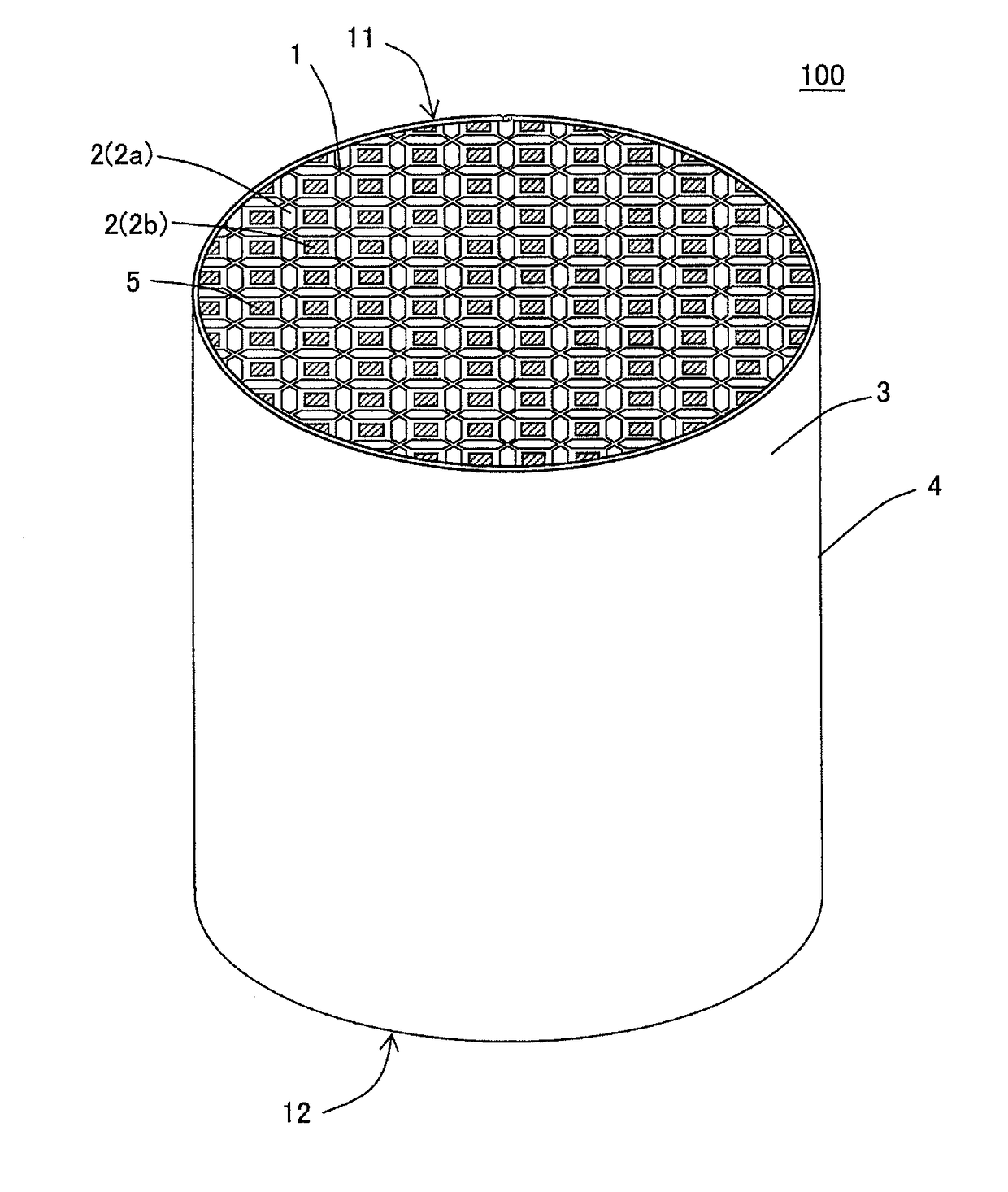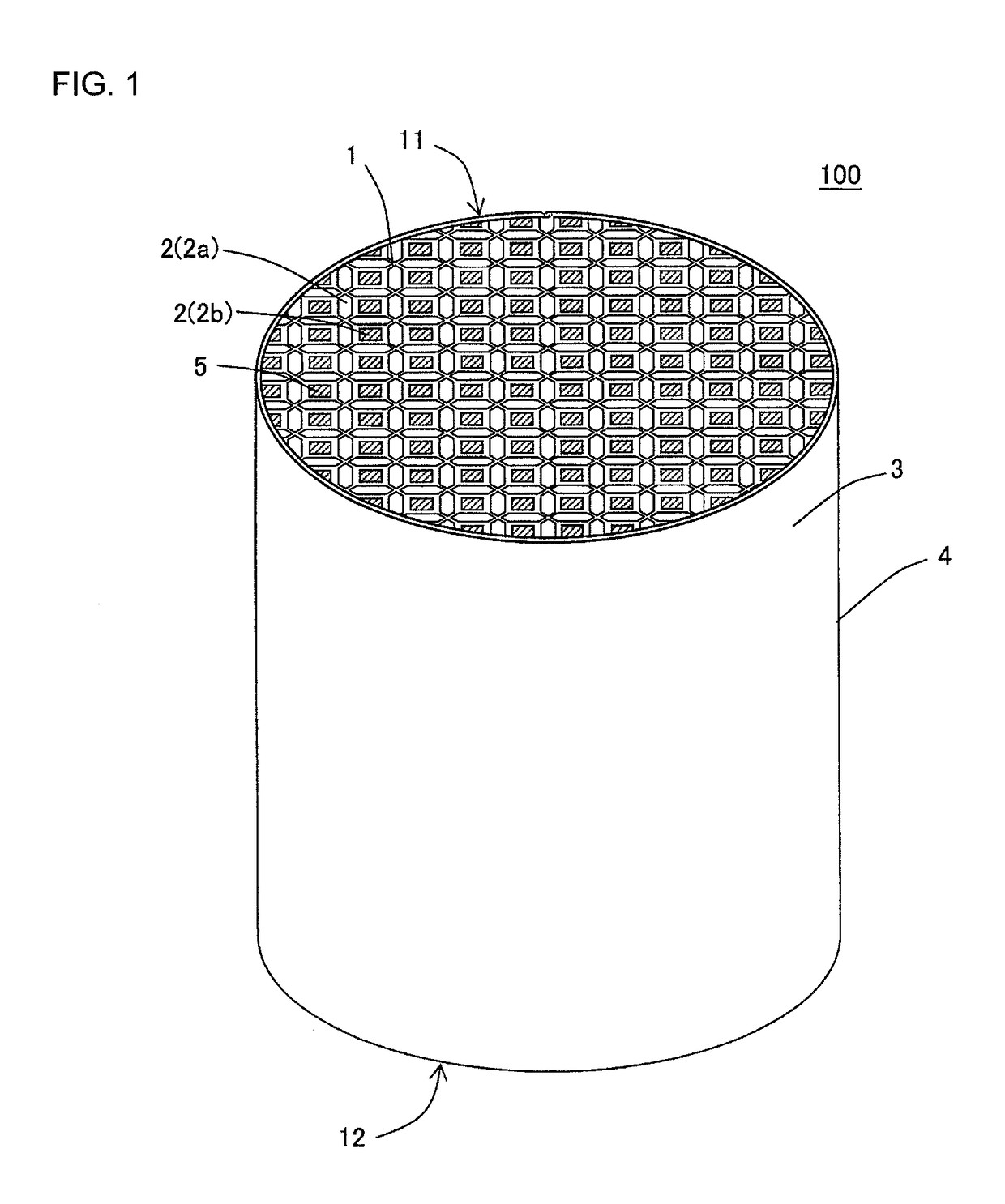Honeycomb filter
a filter and honeycomb technology, applied in the field of honeycomb filters, can solve the problems of increasing the pressure loss of the honeycomb filter, and achieve the effect of small thickness t2, small permeation resistance and low pressure loss
- Summary
- Abstract
- Description
- Claims
- Application Information
AI Technical Summary
Benefits of technology
Problems solved by technology
Method used
Image
Examples
example 1
[0077]Firstly a kneaded material was prepared to produce a honeycomb substrate. In Example 1, for the raw material powder to prepare a kneaded material, silicon carbide (SiC) powder and metal silicon (Si) powder were mixed at the mass ratio of 80:20 to prepare a mixture powder. To the mixture powder, binder, a pore former and water were added to have a forming raw material. Next, the forming raw material was kneaded to have a round pillar-shaped kneaded material.
[0078]Next, the kneaded material was extruded using a die for manufacturing of a honeycomb formed body to have a honeycomb formed body having a round pillar shape as the overall shape.
[0079]Next, this honeycomb formed body was dried by a microwave dryer, and then was dried completely by a hot-air drier, and then both end faces of the honeycomb formed body were cut so as to have predetermined dimensions.
[0080]Next, a plugging portion was formed to the dried honeycomb formed body. Specifically a mask was firstly applied to the...
examples 2 to 30
[0091]A honeycomb filter of this Comparative Example was manufactured similarly to Example 1 other than that “thickness T1 of the first partition wall (μm)”, “thickness T2 of the second partition wall (μm)” and “T1 / T2” were changed as shown in Table 1. For the honeycomb filters of Examples 2 to 30, the “pressure loss” and “thermal shock resistance” were evaluated by the method similar to Example 1. Table 1 shows the result.
examples 31 to 60
[0093]In Examples 31 to 60, the amount of pore former was increased during the preparation of a kneaded material to manufacture a honeycomb substrate as compared with the kneaded material prepared in Example 1, so as to manufacture a honeycomb filter including the partition wall having the porosity of 41%. Honeycomb filters of these Examples were manufactured similarly to Example 1 other than that “thickness T1 of the first partition wall (μm)”, “thickness T2 of the second partition wall (μm)” and “T1 / T2” were changed as shown in Table 2 by using such a kneaded material. For the honeycomb filters of Examples 31 to 60, the “pressure loss” and “thermal shock resistance” were evaluated by the method similar to Example 1. Table 2 shows the result. In Examples 31 to 60, Comparative Example 2 described below was used as their reference honeycomb filter.
PUM
| Property | Measurement | Unit |
|---|---|---|
| thickness T1 | aaaaa | aaaaa |
| length | aaaaa | aaaaa |
| porosity | aaaaa | aaaaa |
Abstract
Description
Claims
Application Information
 Login to View More
Login to View More - R&D
- Intellectual Property
- Life Sciences
- Materials
- Tech Scout
- Unparalleled Data Quality
- Higher Quality Content
- 60% Fewer Hallucinations
Browse by: Latest US Patents, China's latest patents, Technical Efficacy Thesaurus, Application Domain, Technology Topic, Popular Technical Reports.
© 2025 PatSnap. All rights reserved.Legal|Privacy policy|Modern Slavery Act Transparency Statement|Sitemap|About US| Contact US: help@patsnap.com



